Home / The Robinson Annulation
Enols and Enolates
The Robinson Annulation
Last updated: April 1st, 2025 |
The Robinson Annulation
The Robinson Annulation is the name for a process that combines two key reactions you’ve learned previously into one longer sequence.
The reaction begins with a Michael reaction, followed by an intramolecular aldol condensation to give a new six-membered ring containing an alpha, beta unsaturated ketone. This post goes into all the details!
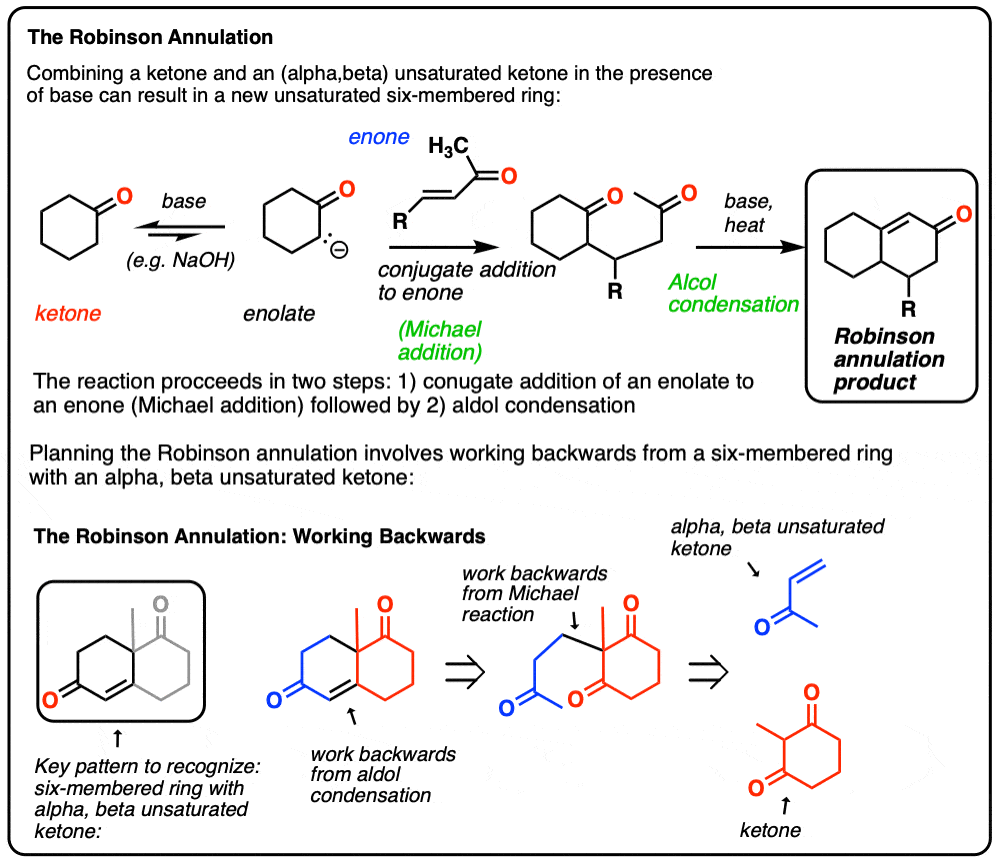
Table of Contents
- Revisiting Intramolecular Reactions
- The Aldol Condensation
- The Intramolecular Aldol Condensation
- Five and Six-Membered Rings Are Favored
- The Michael Reaction Gives 1,5-Diketones
- The Robinson Annulation
- Mechanism of the Robinson Annulation
- Thinking Backwards From the Products
- Bonus: Two modern applications
- Notes
- (Advanced) References and Further Reading
1. Revisiting Intramolecular Reactions
There’s something about intramolecular reactions that often trips students up.
Conceptually, understanding an intramolecular reaction is not much different than understanding what happens when you fasten a belt, making a loop in the process.
However…. I’ve seen students go into an exam thinking they know a reaction cold – but when suddenly confronted with an example of a nucleophile and an electrophile together on the same molecule, they freeze.
This is despite the fact that exactly the same bonds form and break!
It’s OK. Organic chemistry can seem very abstract at first. It can take time to appreciate that all these symbols we draw for molecules are proxies for three-dimensional objects, and follow many of their familiar principles!
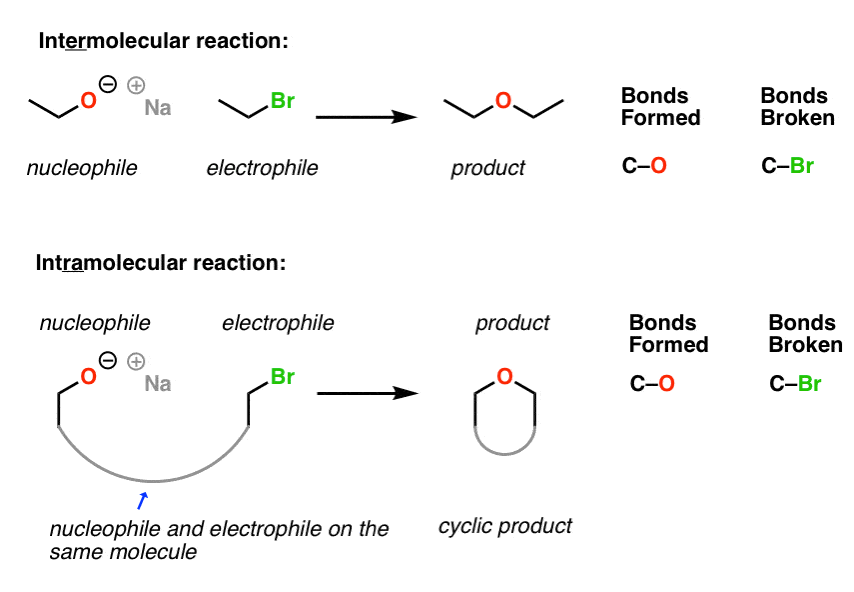
[Previous posts: A Common Blind Spot: Intramolecular Reactions, Intramolecular Formation of Ethers, The Intramolecular Friedel-Crafts Reaction ]
Today it’s the aldol condensation‘s turn for the intramolecular treatment, which is part of a larger process called the Robinson Annulation.
Q. What’s the aldol condensation again?
OK. Quick review.
2. The Aldol Condensation
The base-catalyzed version of the Aldol Condensation begins with formation of a nucleophilic enolate through deprotonation of the “alpha-carbon” of an aldehyde or ketone, and the subsequent addition of this nucleophile to the electrophilic carbonyl carbon of a second aldehyde or ketone, forming a new C-C bond.
Upon heating, the resulting aldol addition product is deprotonated to give a new enolate, which then displaces the hydroxide ion, resulting in a carbon-carbon double bond accompanied by the net loss of water (H2O). [note this is an example of elimination through an E1cb mechanism] The resulting product containing an alpha, beta unsaturated ketone (or aldehyde) is the aldol condensation product.
This picture shows the result of aldol condensation between two molecules of 2-propanone (aka “acetone”).

For a refresher on the mechanism, hover here [ (link)
So what would an intramolecular aldol reaction look like? Drastically different?
3. The Intramolecular Aldol Condensation
No, not drastically different. Actually, all we need to do is replace two of the C–H bonds with a C–C bond that links the two ketones. That’s it!
Now our nucleophile happens to be on the same molecule as our electrophile. So, just like fastening a belt, when the two combine, we obtain a “loop”, or ring.
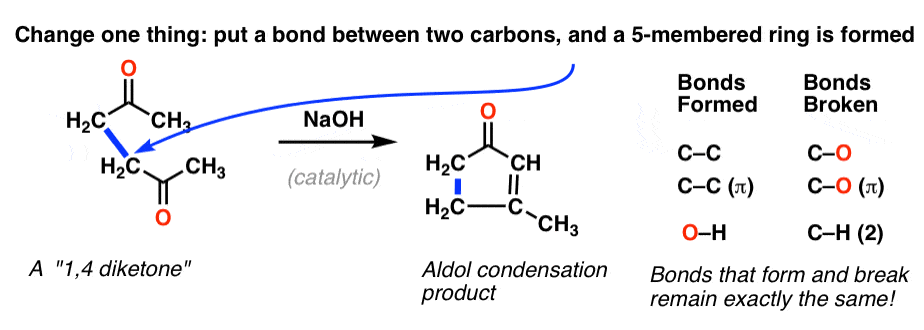
The mechanism is exactly the same. Upon treatment with base (e.g. NaOH) an enolate still forms, and it still adds to a ketone. And after the net loss of H2O, the exact same sequence of bonds has formed and broken. The only difference is that since the two ketones are linked, we now we have a ring!
4. Intramolecular Reactions Favor Five- and Six-Membered Ring Formation
The best candidates for ring closure tend to be five and six-membered rings, which combine low ring strain with a reasonable reaction rate.
Three- and four-membered rings tend to suffer from ring strain. It’s not impossible for 3- and 4-membered rings to form (intramolecular reactions to form epoxides exist, after all – see this post) but in a process where the steps are in equilibrium (and thus potentially reversible), a process that forms an unstrained five- or six-membered ring will be thermodynamically favored over one that forms a three- or four-membered ring. [Note 2]
Seven- and higher-membered rings tend to be slower to form, due to a lower “effective concentration” of the nucleophile in the vicinity of the electrophile.
An example for the formation of a six-membered ring through the intramolecular reaction of a “1,5-diketone” is shown below. [Note: the 1 and 5 here don’t refer to the IUPAC numbering, but to the fact that the second ketone is 4 carbons over from the first one]. The pattern of bonds that form and break is exactly the same as above.
5. The Michael Reaction Gives 1,5-Diketones
We’ve actually already seen a reaction that makes 1,5-diketones: the Michael reaction.
To recap: the Michael reaction involves the addition of a nucleophilic enolate to the “beta” ( β) carbon in the double bond of an alpha,beta-unsaturated ketone in a process called “conjugate addition” or “1,4-addition” [also a prominent reaction of Gilman reagents (organocuprates): see Gilman Reagents: What They’re Used For]. This results in a new enolate. Protonation of this enolate then gives the 1,5-diketone:
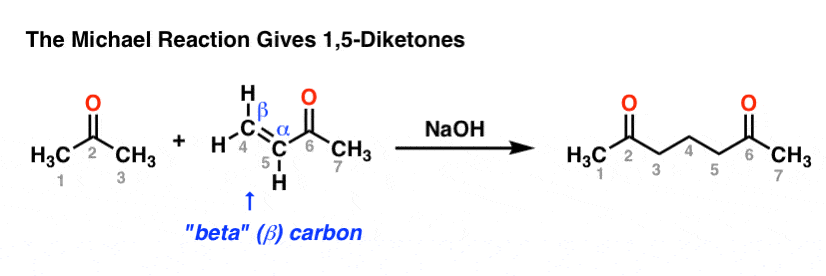
6. The Robinson Annulation
Now let’s join these two threads together. Pattern recognition is a key skill in organic chemistry!
- Since 1,5-diketones can form six-membered rings through an intramolecular Aldol condensation…
- …and 1,5 diketones can be made through the Michael reaction…
- …and furthermore, they both require the same reagent (base, e.g. NaOH)…
then what would happen if we were to stir together a ketone, an alpha,beta-unsaturated ketone, NaOH, and then heat the mixture? Would we end up with an intramolecular aldol condensation product?
Yes! In a 1935 paper, Robert Robinson and collaborator William Rapson reported that a substituted methyl vinyl ketone and cyclohexanone gave a product with a new six membered ring containing an alpha,beta unsaturated ketone:
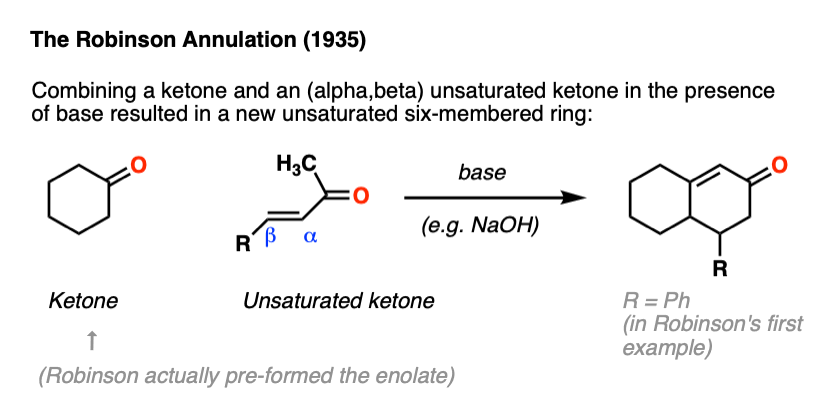
This has become known as the Robinson Annulation, and it still finds use today. [Note 1 ]
The process begins with a Michael reaction and ends with an intramolecular aldol condensation to give the new ring. It is a classic example of a tandem (or cascade) reaction, where an initial reaction provides the starting material for a successive reaction.
7. Mechanism Of The Robinson Annulation
Let’s walk through the whole mechanism, using the simplified example of 2-propanone and methyl vinyl ketone.
The Michael Reaction segment involves three steps:
- formation of the enolate
- conjugate addition, and
- protonation of the new enolate.
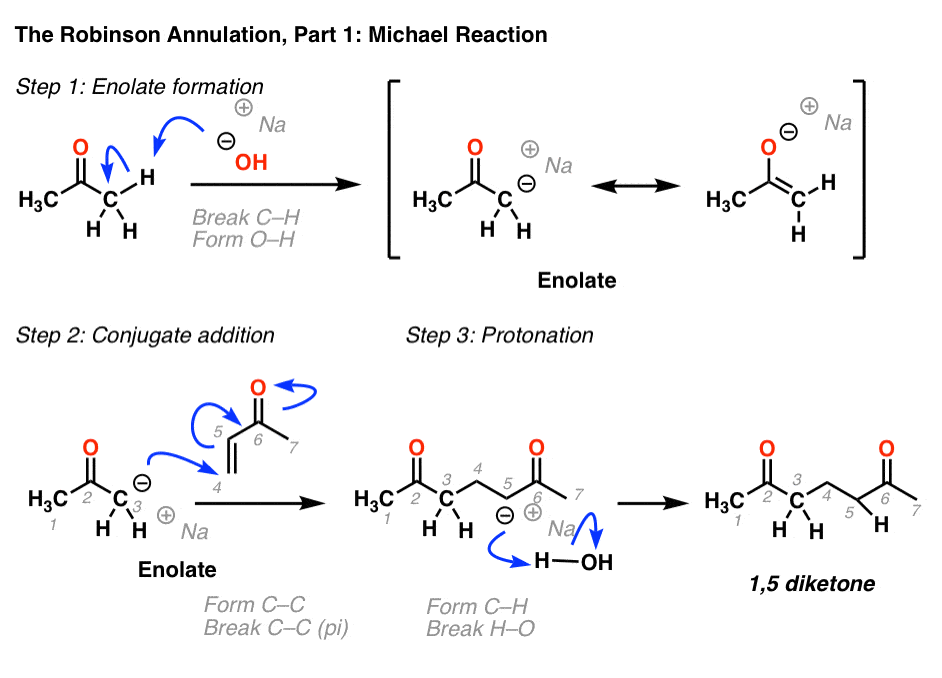
The 1,5-diketone produced by the Michael reaction then becomes the starting material for the next segment of the Robinson annulation, the intramolecular aldol condensation.
- The aldol condensation begins with deprotonation of the 1,5-diketone to give an enolate on C-1 [Note that there are two enolates that could be formed, on C-1 and C-3 (since the molecule is symmetrical, these are equivalent to C-7 and C-5, respectively). However, the C-3 enolate is a dead-end; formation of the (strained) 4-membered ring is reversible, and equilibrium will eventually drive the reaction toward formation of the six-membered aldol condensation product]
- Formation of the enolate on C-1 is followed by attack at the ketone five carbons away, giving the six-membered ring.
- Protonation of the negatively charged oxygen, followed by deprotonation at the adjacent carbon, gives a new enolate.
- This enolate then expels a hydroxide ion (HO- ) from the adjacent carbon, forming a new carbon-carbon double bond, resulting in the aldol condensation product.
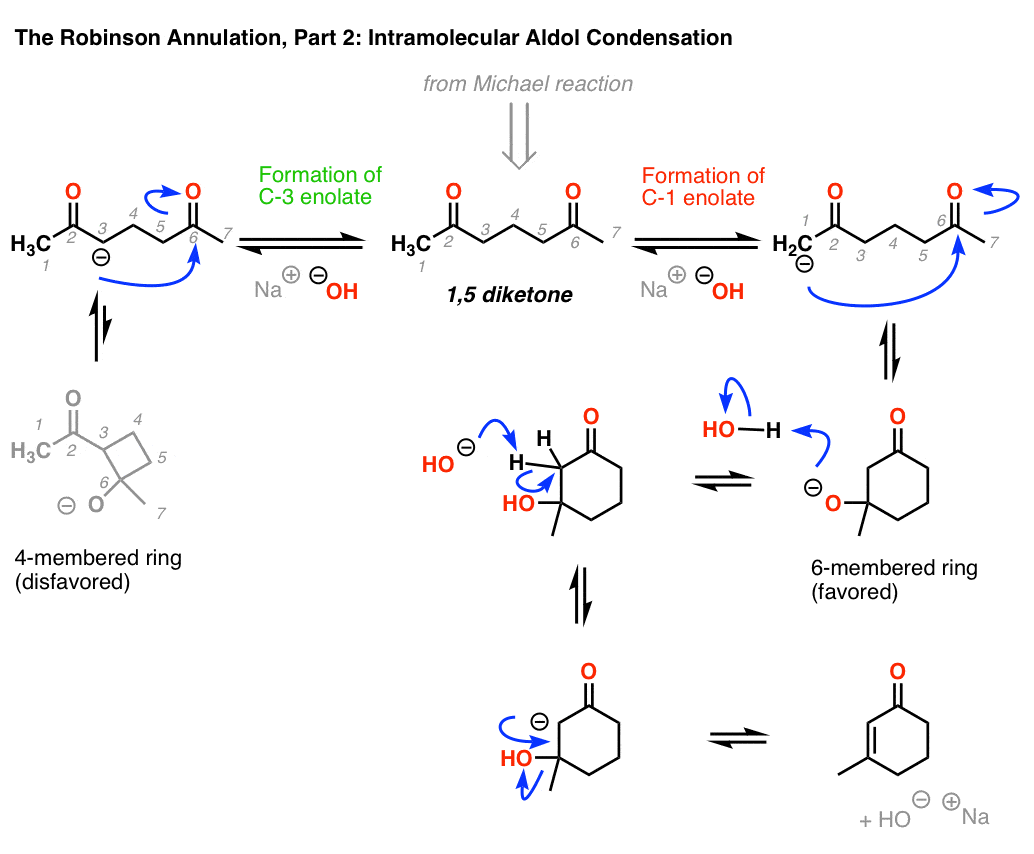
8. Robinson Annulation Retrosynthesis: Working Backwards
It’s extremely important to be able to look at the structure of a product of the Robinson annulation and work backwards to the two components.
- The first step is to recognize the key pattern in the product of a Robinson: a six-membered ring containing a double bond adjacent to a ketone (an alpha, beta unsaturated ketone).
- Next, work backwards from the Aldol condensation: so in the reverse direction, break the C=C bond and place two C-H bonds on one end (the alpha carbon of the ketone) and a C=O bond on the other end.
- Finally, work backwards on the Michael: break the C-C bond, and replace with a C-C pi bond on one component and a C-H bond on the other.
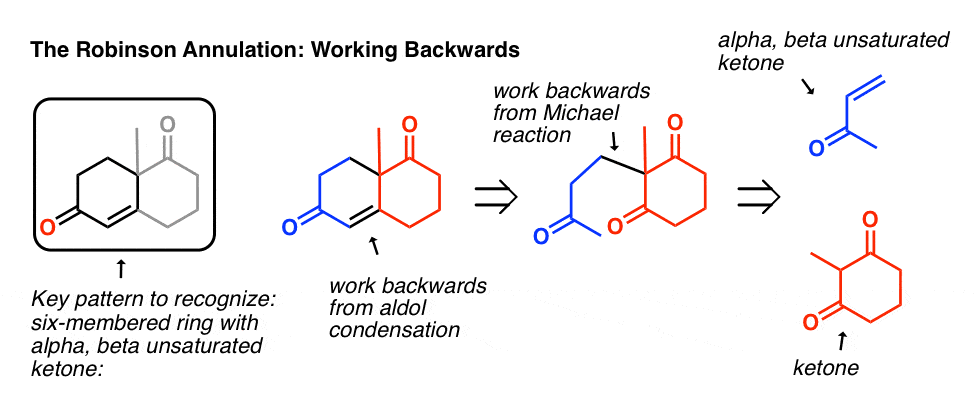
As an exercise, try working backwards from the following examples:

Answers here (click and an image will pop up).
That’s probably enough about the Robinson.
But for the keen, I present two applications of this reaction in synthesis, particularly applied to steroids.
9. Bonus: Two Applications of the Robinson Annulation
You may have noticed that six-membered rings make quite a few appearances in organic chemistry. So the Robinson annulation has found its share of useful applications.
One prominent example is found in the industrial synthesis of the steroid hormone estrone, a precursor of the active component in birth-control drugs.
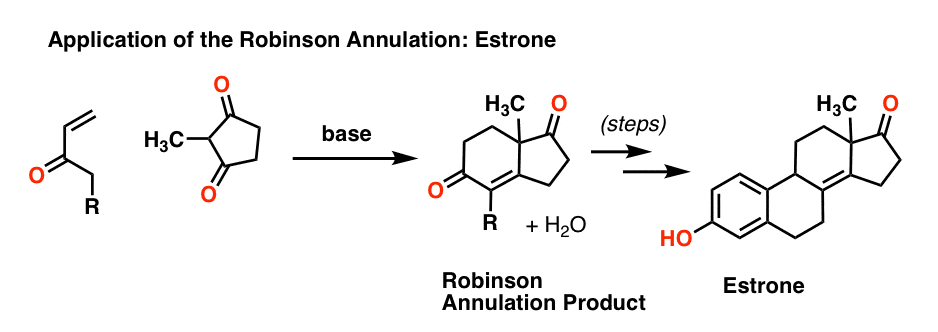
Another example is the synthesis of the molecule below, known as the Wieland-Miescher ketone , another useful precursor for the synthesis of steroids and terpenes:

[See here for the exact procedure. ]
What makes this a particularly high-yielding example is that the pKa of the diketone is about 11, ensuring that it will be deprotonated selectively over the all the other possible alpha-carbons (pKa ~16) helping to ensure that the Michael reaction is relatively high yielding. Furthermore, the methyl group at that position ensures that it can’t be deprotonated again in the intramolecular aldol condensation step.
At this point I will confess that the example above, as written, is a bit of a cheat. While the first step (the Michael) is achieved with the use of potassium hydroxide, it was found that the second step could be accomplished with the use of catalytic (about 10 mol %) pyrrolidine or piperidine, going through an enamine-promoted aldol condensation. [fun exercise: draw this out]

One of the keys here was to employ a Dean-Stark trap that sequesters the water that is formed as a result of the reaction, driving the reaction toward completion.
Fun fact. This intramolecular amine-catalyzed aldol condensation was actually a key sharpening stone in the development of one of the most important areas of modern chemical research.
In 1971, Zoltan Hajos and David Parrish had the bright idea of using (chiral) L-proline instead of pyrrolidine [the cumbersomely named Hajos–Parrish–Eder–Sauer–Wiechert reaction] which resulted in an optically active product. This result sat more or less dormant in the chemical literature for about three decades, until this 2000 paper from Barbas, List and Lerner opened the floodgates on the development of organocatalysis.
Notes
Related Articles
- Aldol Addition and Condensation Reactions
- Gilman Reagents (Organocuprates): What They’re Used For
- The Robinson Annulation (MOC Membership)
- 1,4-addition of enolates to enones (“The Michael Reaction”) (MOC Membership)
- Kinetic Versus Thermodynamic Enolates
- Common Blind Spot: Intramolecular Reactions
- All About Enamines
- E1cB – Elimination (Unimolecular) Conjugate Base
- The Michael Reaction and Conjugate Addition
Note 1. Even within the past few years, new variations of the Robinson Annulation have been developed. An enantioselective example from the Toste lab is highlighted here.
Note 2. Another key factor is that cyclobutene has even more ring strain (30 kcal/mol) than cyclobutane (26 kcal/mol).. Therefore, formation of the 4-membered aldol condensation product is even more unlikely.
(Advanced) References And Further Reading
- Experiments on the synthesis of substances related to the sterols. Part II. A new general method for the synthesis of substituted cyclohexenones
William Sage Rapson and Robert Robinson
J. Chem. Soc., 1935, 1285-1288
DOI: 10.1039/JR9350001285
The original paper by Sir Robert Robinson on a new ring-forming synthetic methodology, which he applied toward the total synthesis of cholesterol and other sterols. - Robinson annelation by reactions of 2-methyl 1,3 diketones with a .beta.-chloro ketone
A. Zoretic, B. Bendiksen, and B. Branchaud
The Journal of Organic Chemistry 1976 41 (23), 3767-3767
DOI: 10.1021/jo00885a029
An example of a Robinson annulation with an experimental procedure provided – this should be fairly robust since the work was carried out by two undergraduates! - (S)-8a-METHYL-3,4,8,8a-TETRAHYDRO-1,6(2H, 7H)-NAPHTHALENEDIONE
Paul Buchschacher, A. Fürst, and J. Gutzwiller
Org. Synth. 1985, 63, 37
DOI: 10.15227/orgsyn.063.0037
The title compound in this procedure from Organic Syntheses is also known as the Wieland-Miescher ketone, a common building block in the total synthesis of steroids and terpenoids. - The Robinson Annelation and Related Reactions
Robert E. GAWLEY
Synthesis 1976; 1976 (12): 777-794
DOI: 10.1055/s-1976-24200
Even though this review might be over 40 years old by now, it is still a useful reference for the Robinson Annulation and related chemistry.
- A proline-catalyzed asymmetric Robinson annulation reaction
Tommy Bui, Carlos F. Barbas, III
Tetrahedron Letters Volume 41, Issue 36, September 2000, Pages 6951-6954
DOI: 1016/S0040-4039(00)01180-1
The amino acid proline can catalyze Robinson Annulations, as demonstrated in this paper which was one of the early examples of an exciting new field, organocatalysis. - Total Synthesis of (−)-Anominine
Ben Bradshaw, Gorka Etxebarria-Jardí, and Josep Bonjoch
Journal of the American Chemical Society 2010 132 (17), 5966-5967
DOI: 1021/ja101994q
An asymmetric Robinson Annulation (2 -> 3) served as the starting point in this natural product total synthesis. - Acid-catalyzed Robinson Annelations
Clayton H. Heathcock, John E. Ellis, John E. McMurry, Anthony Coppolino,
Tetrahedron Letters, 12(52), 1971, 4995-4996
DOI: 10.1016/S0040-4039(01)97609-9.This study contains several examples of acid-catalyzed Robinson annulations (using H2SO4)
00 General Chemistry Review
01 Bonding, Structure, and Resonance
- How Do We Know Methane (CH4) Is Tetrahedral?
- Hybrid Orbitals and Hybridization
- How To Determine Hybridization: A Shortcut
- Orbital Hybridization And Bond Strengths
- Sigma bonds come in six varieties: Pi bonds come in one
- A Key Skill: How to Calculate Formal Charge
- The Four Intermolecular Forces and How They Affect Boiling Points
- 3 Trends That Affect Boiling Points
- How To Use Electronegativity To Determine Electron Density (and why NOT to trust formal charge)
- Introduction to Resonance
- How To Use Curved Arrows To Interchange Resonance Forms
- Evaluating Resonance Forms (1) - The Rule of Least Charges
- How To Find The Best Resonance Structure By Applying Electronegativity
- Evaluating Resonance Structures With Negative Charges
- Evaluating Resonance Structures With Positive Charge
- Exploring Resonance: Pi-Donation
- Exploring Resonance: Pi-acceptors
- In Summary: Evaluating Resonance Structures
- Drawing Resonance Structures: 3 Common Mistakes To Avoid
- How to apply electronegativity and resonance to understand reactivity
- Bond Hybridization Practice
- Structure and Bonding Practice Quizzes
- Resonance Structures Practice
02 Acid Base Reactions
- Introduction to Acid-Base Reactions
- Acid Base Reactions In Organic Chemistry
- The Stronger The Acid, The Weaker The Conjugate Base
- Walkthrough of Acid-Base Reactions (3) - Acidity Trends
- Five Key Factors That Influence Acidity
- Acid-Base Reactions: Introducing Ka and pKa
- How to Use a pKa Table
- The pKa Table Is Your Friend
- A Handy Rule of Thumb for Acid-Base Reactions
- Acid Base Reactions Are Fast
- pKa Values Span 60 Orders Of Magnitude
- How Protonation and Deprotonation Affect Reactivity
- Acid Base Practice Problems
03 Alkanes and Nomenclature
- Meet the (Most Important) Functional Groups
- Condensed Formulas: Deciphering What the Brackets Mean
- Hidden Hydrogens, Hidden Lone Pairs, Hidden Counterions
- Don't Be Futyl, Learn The Butyls
- Primary, Secondary, Tertiary, Quaternary In Organic Chemistry
- Branching, and Its Affect On Melting and Boiling Points
- The Many, Many Ways of Drawing Butane
- Wedge And Dash Convention For Tetrahedral Carbon
- Common Mistakes in Organic Chemistry: Pentavalent Carbon
- Table of Functional Group Priorities for Nomenclature
- Summary Sheet - Alkane Nomenclature
- Organic Chemistry IUPAC Nomenclature Demystified With A Simple Puzzle Piece Approach
- Boiling Point Quizzes
- Organic Chemistry Nomenclature Quizzes
04 Conformations and Cycloalkanes
- Staggered vs Eclipsed Conformations of Ethane
- Conformational Isomers of Propane
- Newman Projection of Butane (and Gauche Conformation)
- Introduction to Cycloalkanes
- Geometric Isomers In Small Rings: Cis And Trans Cycloalkanes
- Calculation of Ring Strain In Cycloalkanes
- Cycloalkanes - Ring Strain In Cyclopropane And Cyclobutane
- Cyclohexane Conformations
- Cyclohexane Chair Conformation: An Aerial Tour
- How To Draw The Cyclohexane Chair Conformation
- The Cyclohexane Chair Flip
- The Cyclohexane Chair Flip - Energy Diagram
- Substituted Cyclohexanes - Axial vs Equatorial
- Ranking The Bulkiness Of Substituents On Cyclohexanes: "A-Values"
- Cyclohexane Chair Conformation Stability: Which One Is Lower Energy?
- Fused Rings - Cis-Decalin and Trans-Decalin
- Naming Bicyclic Compounds - Fused, Bridged, and Spiro
- Bredt's Rule (And Summary of Cycloalkanes)
- Newman Projection Practice
- Cycloalkanes Practice Problems
05 A Primer On Organic Reactions
- The Most Important Question To Ask When Learning a New Reaction
- Curved Arrows (for reactions)
- Nucleophiles and Electrophiles
- The Three Classes of Nucleophiles
- Nucleophilicity vs. Basicity
- What Makes A Good Nucleophile?
- What Makes A Good Leaving Group?
- 3 Factors That Stabilize Carbocations
- Equilibrium and Energy Relationships
- 7 Factors that stabilize negative charge in organic chemistry
- 7 Factors That Stabilize Positive Charge in Organic Chemistry
- What's a Transition State?
- Hammond's Postulate
- Learning Organic Chemistry Reactions: A Checklist (PDF)
- Introduction to Oxidative Cleavage Reactions
06 Free Radical Reactions
- Bond Dissociation Energies = Homolytic Cleavage
- Free Radical Reactions
- 3 Factors That Stabilize Free Radicals
- What Factors Destabilize Free Radicals?
- Bond Strengths And Radical Stability
- Free Radical Initiation: Why Is "Light" Or "Heat" Required?
- Initiation, Propagation, Termination
- Monochlorination Products Of Propane, Pentane, And Other Alkanes
- Selectivity In Free Radical Reactions
- Selectivity in Free Radical Reactions: Bromination vs. Chlorination
- Halogenation At Tiffany's
- Allylic Bromination
- Bonus Topic: Allylic Rearrangements
- In Summary: Free Radicals
- Synthesis (2) - Reactions of Alkanes
- Free Radicals Practice Quizzes
07 Stereochemistry and Chirality
- Types of Isomers: Constitutional Isomers, Stereoisomers, Enantiomers, and Diastereomers
- How To Draw The Enantiomer Of A Chiral Molecule
- How To Draw A Bond Rotation
- Introduction to Assigning (R) and (S): The Cahn-Ingold-Prelog Rules
- Assigning Cahn-Ingold-Prelog (CIP) Priorities (2) - The Method of Dots
- Enantiomers vs Diastereomers vs The Same? Two Methods For Solving Problems
- Assigning R/S To Newman Projections (And Converting Newman To Line Diagrams)
- How To Determine R and S Configurations On A Fischer Projection
- The Meso Trap
- Optical Rotation, Optical Activity, and Specific Rotation
- Optical Purity and Enantiomeric Excess
- What's a Racemic Mixture?
- Chiral Allenes And Chiral Axes
- Stereochemistry Practice Problems and Quizzes
08 Substitution Reactions
- Nucleophilic Substitution Reactions - Introduction
- Two Types of Nucleophilic Substitution Reactions
- The SN2 Mechanism
- Why the SN2 Reaction Is Powerful
- The SN1 Mechanism
- The Conjugate Acid Is A Better Leaving Group
- Comparing the SN1 and SN2 Reactions
- Polar Protic? Polar Aprotic? Nonpolar? All About Solvents
- Steric Hindrance is Like a Fat Goalie
- Common Blind Spot: Intramolecular Reactions
- Substitution Practice - SN1
- Substitution Practice - SN2
09 Elimination Reactions
- Elimination Reactions (1): Introduction And The Key Pattern
- Elimination Reactions (2): The Zaitsev Rule
- Elimination Reactions Are Favored By Heat
- Two Elimination Reaction Patterns
- The E1 Reaction
- The E2 Mechanism
- E1 vs E2: Comparing the E1 and E2 Reactions
- Antiperiplanar Relationships: The E2 Reaction and Cyclohexane Rings
- Bulky Bases in Elimination Reactions
- Comparing the E1 vs SN1 Reactions
- Elimination (E1) Reactions With Rearrangements
- E1cB - Elimination (Unimolecular) Conjugate Base
- Elimination (E1) Practice Problems And Solutions
- Elimination (E2) Practice Problems and Solutions
10 Rearrangements
11 SN1/SN2/E1/E2 Decision
- Identifying Where Substitution and Elimination Reactions Happen
- Deciding SN1/SN2/E1/E2 (1) - The Substrate
- Deciding SN1/SN2/E1/E2 (2) - The Nucleophile/Base
- SN1 vs E1 and SN2 vs E2 : The Temperature
- Deciding SN1/SN2/E1/E2 - The Solvent
- Wrapup: The Key Factors For Determining SN1/SN2/E1/E2
- Alkyl Halide Reaction Map And Summary
- SN1 SN2 E1 E2 Practice Problems
12 Alkene Reactions
- E and Z Notation For Alkenes (+ Cis/Trans)
- Alkene Stability
- Alkene Addition Reactions: "Regioselectivity" and "Stereoselectivity" (Syn/Anti)
- Stereoselective and Stereospecific Reactions
- Hydrohalogenation of Alkenes and Markovnikov's Rule
- Hydration of Alkenes With Aqueous Acid
- Rearrangements in Alkene Addition Reactions
- Halogenation of Alkenes and Halohydrin Formation
- Oxymercuration Demercuration of Alkenes
- Hydroboration Oxidation of Alkenes
- m-CPBA (meta-chloroperoxybenzoic acid)
- OsO4 (Osmium Tetroxide) for Dihydroxylation of Alkenes
- Palladium on Carbon (Pd/C) for Catalytic Hydrogenation of Alkenes
- Cyclopropanation of Alkenes
- A Fourth Alkene Addition Pattern - Free Radical Addition
- Alkene Reactions: Ozonolysis
- Summary: Three Key Families Of Alkene Reaction Mechanisms
- Synthesis (4) - Alkene Reaction Map, Including Alkyl Halide Reactions
- Alkene Reactions Practice Problems
13 Alkyne Reactions
- Acetylides from Alkynes, And Substitution Reactions of Acetylides
- Partial Reduction of Alkynes With Lindlar's Catalyst
- Partial Reduction of Alkynes With Na/NH3 To Obtain Trans Alkenes
- Alkyne Hydroboration With "R2BH"
- Hydration and Oxymercuration of Alkynes
- Hydrohalogenation of Alkynes
- Alkyne Halogenation: Bromination, Chlorination, and Iodination of Alkynes
- Alkyne Reactions - The "Concerted" Pathway
- Alkenes To Alkynes Via Halogenation And Elimination Reactions
- Alkynes Are A Blank Canvas
- Synthesis (5) - Reactions of Alkynes
- Alkyne Reactions Practice Problems With Answers
14 Alcohols, Epoxides and Ethers
- Alcohols - Nomenclature and Properties
- Alcohols Can Act As Acids Or Bases (And Why It Matters)
- Alcohols - Acidity and Basicity
- The Williamson Ether Synthesis
- Ethers From Alkenes, Tertiary Alkyl Halides and Alkoxymercuration
- Alcohols To Ethers via Acid Catalysis
- Cleavage Of Ethers With Acid
- Epoxides - The Outlier Of The Ether Family
- Opening of Epoxides With Acid
- Epoxide Ring Opening With Base
- Making Alkyl Halides From Alcohols
- Tosylates And Mesylates
- PBr3 and SOCl2
- Elimination Reactions of Alcohols
- Elimination of Alcohols To Alkenes With POCl3
- Alcohol Oxidation: "Strong" and "Weak" Oxidants
- Demystifying The Mechanisms of Alcohol Oxidations
- Protecting Groups For Alcohols
- Thiols And Thioethers
- Calculating the oxidation state of a carbon
- Oxidation and Reduction in Organic Chemistry
- Oxidation Ladders
- SOCl2 Mechanism For Alcohols To Alkyl Halides: SN2 versus SNi
- Alcohol Reactions Roadmap (PDF)
- Alcohol Reaction Practice Problems
- Epoxide Reaction Quizzes
- Oxidation and Reduction Practice Quizzes
15 Organometallics
- What's An Organometallic?
- Formation of Grignard and Organolithium Reagents
- Organometallics Are Strong Bases
- Reactions of Grignard Reagents
- Protecting Groups In Grignard Reactions
- Synthesis Problems Involving Grignard Reagents
- Grignard Reactions And Synthesis (2)
- Organocuprates (Gilman Reagents): How They're Made
- Gilman Reagents (Organocuprates): What They're Used For
- The Heck, Suzuki, and Olefin Metathesis Reactions (And Why They Don't Belong In Most Introductory Organic Chemistry Courses)
- Reaction Map: Reactions of Organometallics
- Grignard Practice Problems
16 Spectroscopy
- Degrees of Unsaturation (or IHD, Index of Hydrogen Deficiency)
- Conjugation And Color (+ How Bleach Works)
- Introduction To UV-Vis Spectroscopy
- UV-Vis Spectroscopy: Absorbance of Carbonyls
- UV-Vis Spectroscopy: Practice Questions
- Bond Vibrations, Infrared Spectroscopy, and the "Ball and Spring" Model
- Infrared Spectroscopy: A Quick Primer On Interpreting Spectra
- IR Spectroscopy: 4 Practice Problems
- 1H NMR: How Many Signals?
- Homotopic, Enantiotopic, Diastereotopic
- Diastereotopic Protons in 1H NMR Spectroscopy: Examples
- 13-C NMR - How Many Signals
- Liquid Gold: Pheromones In Doe Urine
- Natural Product Isolation (1) - Extraction
- Natural Product Isolation (2) - Purification Techniques, An Overview
- Structure Determination Case Study: Deer Tarsal Gland Pheromone
17 Dienes and MO Theory
- What To Expect In Organic Chemistry 2
- Are these molecules conjugated?
- Conjugation And Resonance In Organic Chemistry
- Bonding And Antibonding Pi Orbitals
- Molecular Orbitals of The Allyl Cation, Allyl Radical, and Allyl Anion
- Pi Molecular Orbitals of Butadiene
- Reactions of Dienes: 1,2 and 1,4 Addition
- Thermodynamic and Kinetic Products
- More On 1,2 and 1,4 Additions To Dienes
- s-cis and s-trans
- The Diels-Alder Reaction
- Cyclic Dienes and Dienophiles in the Diels-Alder Reaction
- Stereochemistry of the Diels-Alder Reaction
- Exo vs Endo Products In The Diels Alder: How To Tell Them Apart
- HOMO and LUMO In the Diels Alder Reaction
- Why Are Endo vs Exo Products Favored in the Diels-Alder Reaction?
- Diels-Alder Reaction: Kinetic and Thermodynamic Control
- The Retro Diels-Alder Reaction
- The Intramolecular Diels Alder Reaction
- Regiochemistry In The Diels-Alder Reaction
- The Cope and Claisen Rearrangements
- Electrocyclic Reactions
- Electrocyclic Ring Opening And Closure (2) - Six (or Eight) Pi Electrons
- Diels Alder Practice Problems
- Molecular Orbital Theory Practice
18 Aromaticity
- Introduction To Aromaticity
- Rules For Aromaticity
- Huckel's Rule: What Does 4n+2 Mean?
- Aromatic, Non-Aromatic, or Antiaromatic? Some Practice Problems
- Antiaromatic Compounds and Antiaromaticity
- The Pi Molecular Orbitals of Benzene
- The Pi Molecular Orbitals of Cyclobutadiene
- Frost Circles
- Aromaticity Practice Quizzes
19 Reactions of Aromatic Molecules
- Electrophilic Aromatic Substitution: Introduction
- Activating and Deactivating Groups In Electrophilic Aromatic Substitution
- Electrophilic Aromatic Substitution - The Mechanism
- Ortho-, Para- and Meta- Directors in Electrophilic Aromatic Substitution
- Understanding Ortho, Para, and Meta Directors
- Why are halogens ortho- para- directors?
- Disubstituted Benzenes: The Strongest Electron-Donor "Wins"
- Electrophilic Aromatic Substitutions (1) - Halogenation of Benzene
- Electrophilic Aromatic Substitutions (2) - Nitration and Sulfonation
- EAS Reactions (3) - Friedel-Crafts Acylation and Friedel-Crafts Alkylation
- Intramolecular Friedel-Crafts Reactions
- Nucleophilic Aromatic Substitution (NAS)
- Nucleophilic Aromatic Substitution (2) - The Benzyne Mechanism
- Reactions on the "Benzylic" Carbon: Bromination And Oxidation
- The Wolff-Kishner, Clemmensen, And Other Carbonyl Reductions
- More Reactions on the Aromatic Sidechain: Reduction of Nitro Groups and the Baeyer Villiger
- Aromatic Synthesis (1) - "Order Of Operations"
- Synthesis of Benzene Derivatives (2) - Polarity Reversal
- Aromatic Synthesis (3) - Sulfonyl Blocking Groups
- Birch Reduction
- Synthesis (7): Reaction Map of Benzene and Related Aromatic Compounds
- Aromatic Reactions and Synthesis Practice
- Electrophilic Aromatic Substitution Practice Problems
20 Aldehydes and Ketones
- What's The Alpha Carbon In Carbonyl Compounds?
- Nucleophilic Addition To Carbonyls
- Aldehydes and Ketones: 14 Reactions With The Same Mechanism
- Sodium Borohydride (NaBH4) Reduction of Aldehydes and Ketones
- Grignard Reagents For Addition To Aldehydes and Ketones
- Wittig Reaction
- Hydrates, Hemiacetals, and Acetals
- Imines - Properties, Formation, Reactions, and Mechanisms
- All About Enamines
- Breaking Down Carbonyl Reaction Mechanisms: Reactions of Anionic Nucleophiles (Part 2)
- Aldehydes Ketones Reaction Practice
21 Carboxylic Acid Derivatives
- Nucleophilic Acyl Substitution (With Negatively Charged Nucleophiles)
- Addition-Elimination Mechanisms With Neutral Nucleophiles (Including Acid Catalysis)
- Basic Hydrolysis of Esters - Saponification
- Transesterification
- Proton Transfer
- Fischer Esterification - Carboxylic Acid to Ester Under Acidic Conditions
- Lithium Aluminum Hydride (LiAlH4) For Reduction of Carboxylic Acid Derivatives
- LiAlH[Ot-Bu]3 For The Reduction of Acid Halides To Aldehydes
- Di-isobutyl Aluminum Hydride (DIBAL) For The Partial Reduction of Esters and Nitriles
- Amide Hydrolysis
- Thionyl Chloride (SOCl2)
- Diazomethane (CH2N2)
- Carbonyl Chemistry: Learn Six Mechanisms For the Price Of One
- Making Music With Mechanisms (PADPED)
- Carboxylic Acid Derivatives Practice Questions
22 Enols and Enolates
- Keto-Enol Tautomerism
- Enolates - Formation, Stability, and Simple Reactions
- Kinetic Versus Thermodynamic Enolates
- Aldol Addition and Condensation Reactions
- Reactions of Enols - Acid-Catalyzed Aldol, Halogenation, and Mannich Reactions
- Claisen Condensation and Dieckmann Condensation
- Decarboxylation
- The Malonic Ester and Acetoacetic Ester Synthesis
- The Michael Addition Reaction and Conjugate Addition
- The Robinson Annulation
- Haloform Reaction
- The Hell–Volhard–Zelinsky Reaction
- Enols and Enolates Practice Quizzes
23 Amines
- The Amide Functional Group: Properties, Synthesis, and Nomenclature
- Basicity of Amines And pKaH
- 5 Key Basicity Trends of Amines
- The Mesomeric Effect And Aromatic Amines
- Nucleophilicity of Amines
- Alkylation of Amines (Sucks!)
- Reductive Amination
- The Gabriel Synthesis
- Some Reactions of Azides
- The Hofmann Elimination
- The Hofmann and Curtius Rearrangements
- The Cope Elimination
- Protecting Groups for Amines - Carbamates
- The Strecker Synthesis of Amino Acids
- Introduction to Peptide Synthesis
- Reactions of Diazonium Salts: Sandmeyer and Related Reactions
- Amine Practice Questions
24 Carbohydrates
- D and L Notation For Sugars
- Pyranoses and Furanoses: Ring-Chain Tautomerism In Sugars
- What is Mutarotation?
- Reducing Sugars
- The Big Damn Post Of Carbohydrate-Related Chemistry Definitions
- The Haworth Projection
- Converting a Fischer Projection To A Haworth (And Vice Versa)
- Reactions of Sugars: Glycosylation and Protection
- The Ruff Degradation and Kiliani-Fischer Synthesis
- Isoelectric Points of Amino Acids (and How To Calculate Them)
- Carbohydrates Practice
- Amino Acid Quizzes
25 Fun and Miscellaneous
- A Gallery of Some Interesting Molecules From Nature
- Screw Organic Chemistry, I'm Just Going To Write About Cats
- On Cats, Part 1: Conformations and Configurations
- On Cats, Part 2: Cat Line Diagrams
- On Cats, Part 4: Enantiocats
- On Cats, Part 6: Stereocenters
- Organic Chemistry Is Shit
- The Organic Chemistry Behind "The Pill"
- Maybe they should call them, "Formal Wins" ?
- Why Do Organic Chemists Use Kilocalories?
- The Principle of Least Effort
- Organic Chemistry GIFS - Resonance Forms
- Reproducibility In Organic Chemistry
- What Holds The Nucleus Together?
- How Reactions Are Like Music
- Organic Chemistry and the New MCAT
26 Organic Chemistry Tips and Tricks
- Common Mistakes: Formal Charges Can Mislead
- Partial Charges Give Clues About Electron Flow
- Draw The Ugly Version First
- Organic Chemistry Study Tips: Learn the Trends
- The 8 Types of Arrows In Organic Chemistry, Explained
- Top 10 Skills To Master Before An Organic Chemistry 2 Final
- Common Mistakes with Carbonyls: Carboxylic Acids... Are Acids!
- Planning Organic Synthesis With "Reaction Maps"
- Alkene Addition Pattern #1: The "Carbocation Pathway"
- Alkene Addition Pattern #2: The "Three-Membered Ring" Pathway
- Alkene Addition Pattern #3: The "Concerted" Pathway
- Number Your Carbons!
- The 4 Major Classes of Reactions in Org 1
- How (and why) electrons flow
- Grossman's Rule
- Three Exam Tips
- A 3-Step Method For Thinking Through Synthesis Problems
- Putting It Together
- Putting Diels-Alder Products in Perspective
- The Ups and Downs of Cyclohexanes
- The Most Annoying Exceptions in Org 1 (Part 1)
- The Most Annoying Exceptions in Org 1 (Part 2)
- The Marriage May Be Bad, But the Divorce Still Costs Money
- 9 Nomenclature Conventions To Know
- Nucleophile attacks Electrophile
27 Case Studies of Successful O-Chem Students
- Success Stories: How Corina Got The The "Hard" Professor - And Got An A+ Anyway
- How Helena Aced Organic Chemistry
- From a "Drop" To B+ in Org 2 – How A Hard Working Student Turned It Around
- How Serge Aced Organic Chemistry
- Success Stories: How Zach Aced Organic Chemistry 1
- Success Stories: How Kari Went From C– to B+
- How Esther Bounced Back From a "C" To Get A's In Organic Chemistry 1 And 2
- How Tyrell Got The Highest Grade In Her Organic Chemistry Course
- This Is Why Students Use Flashcards
- Success Stories: How Stu Aced Organic Chemistry
- How John Pulled Up His Organic Chemistry Exam Grades
- Success Stories: How Nathan Aced Organic Chemistry (Without It Taking Over His Life)
- How Chris Aced Org 1 and Org 2
- Interview: How Jay Got an A+ In Organic Chemistry
- How to Do Well in Organic Chemistry: One Student's Advice
- "America's Top TA" Shares His Secrets For Teaching O-Chem
- "Organic Chemistry Is Like..." - A Few Metaphors
- How To Do Well In Organic Chemistry: Advice From A Tutor
- Guest post: "I went from being afraid of tests to actually looking forward to them".
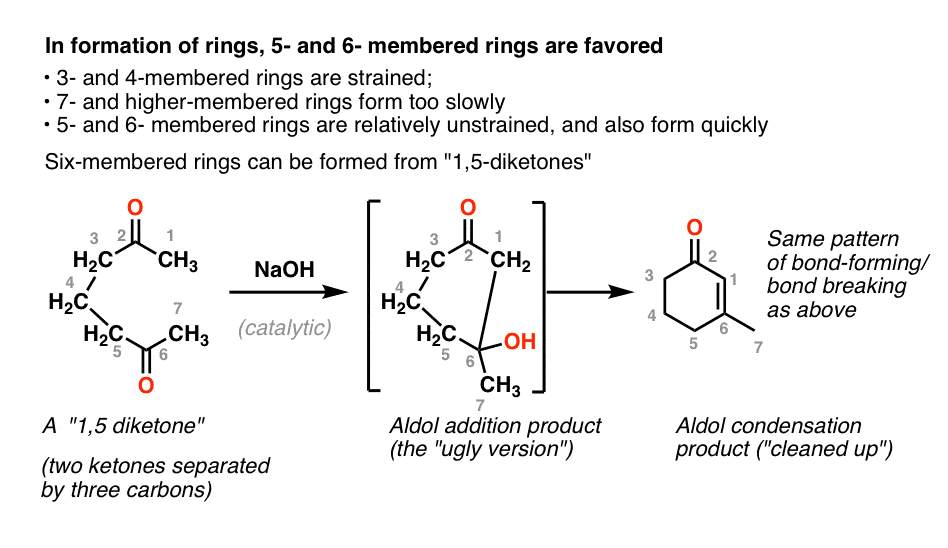
When doing the Robinson annulation with methyl vinyl ketone and 1,3-cyclohexanedione, which carbon would be deprotonated to form the enolate?
The most acidic carbon on these two starting materials, which is….. (?)
.
.
.
.
.
the 1,3 diketone
The link for the Michael addition post in related articles does not work (still found it through Google search but wanted to let you know). This website has been an absolute lifesaver, thank you for all that you do :)
Thank you! Fixed
Thanks James sir! Was a new topic for me but I’ve got it now
This is a well detailed notes.
It clearly explain and demonstrate Robinson annulation. Nice one
First time commenting here. May I know if using a Stork enamine reaction in the Michael addition step will lead to a higher yield of the bicyclic product? I have read that enolates are not particularly good Michael donors so they will favor the attack of the carbonyl carbon to undergo an aldol condensation instead of a Michael reaction.
Hard to generalize. Are you planning on a michael addition to an alpha-beta unsaturated ketone or a an alpha beta unsaturated aldehyde? If you’re using the ketone, the conjugate addition pathway should be fine (I’d be more conerned about an aldol if it was to an aldehyde).
Keep in mind that with a Stork enamine you are going to make the less-substituted enamine, so that is another thing to consider.
Is this for a reaction you are going to perform in the lab or is this “on paper”?
FIXED
Can you please post answers for the retrosynthetic Robinson annulation? Thanks
Thank you so much for such a detailed explanation!!
This website has been amazing. It has been a better teaching resource than any textbook. In the 1935 Robinson example, the R (or Ph) should be shifted one carbon to the right in the product (see 1935 reference).
Thank you and I am very glad you find the site helpful. James
In the Robinson (1935) example, should the R group be in the beta carbon (it appears on the gamma carbon in the product)?
Shoot, will fix, thank you for the heads up.
Sorry for the delay: right here: https://www.masterorganicchemistry.com/wp-content/uploads/2020/12/supp-robinson-annulation-answers-compressed.gif
Yes – right here: https://www.masterorganicchemistry.com/wp-content/uploads/2020/12/supp-robinson-annulation-answers-compressed.gif
Can you post answers for the Robinson Annulation questions?
please send me the answers
Thanks for the great page!
Would you be able to post the answers please?
Thank you so much for uploading such a clear post for Robinson Annulation! I’ve been looking everywhere to understand this reaction, but I never found the good one until I saw your post today! It looks like this is pretty recent post, so I guess I’m so lucky to see this post now. Hope you have a great Christmas, and thank you so much for sharing this post for free! :)
Glad you found it useful Jennifer!
Can I get the answers? Thanks!